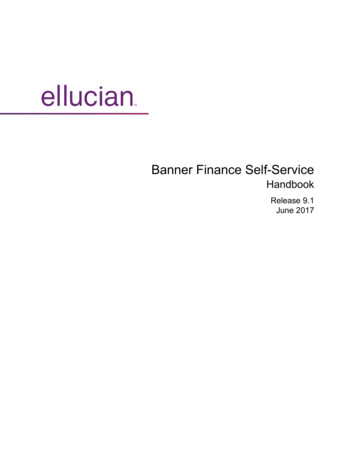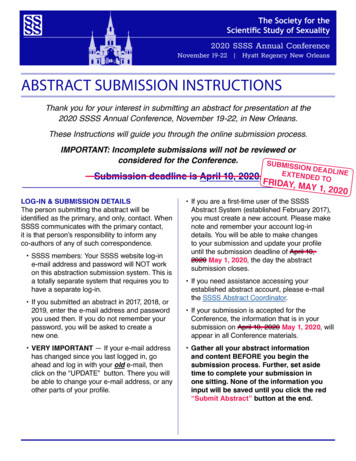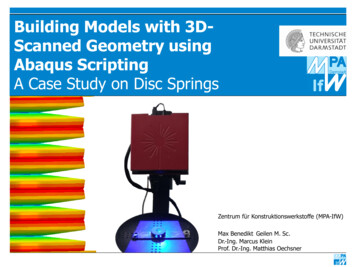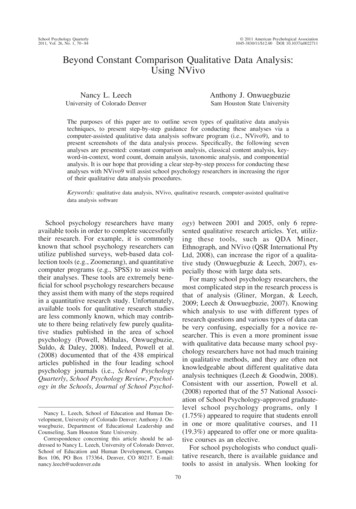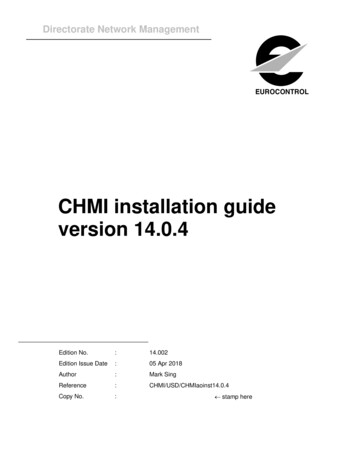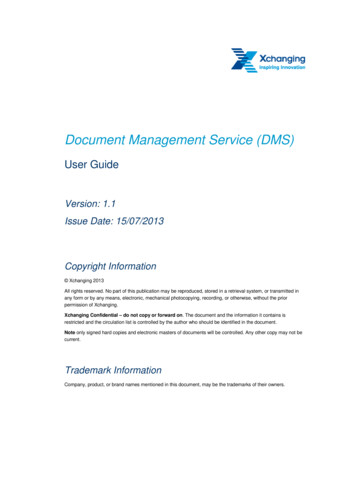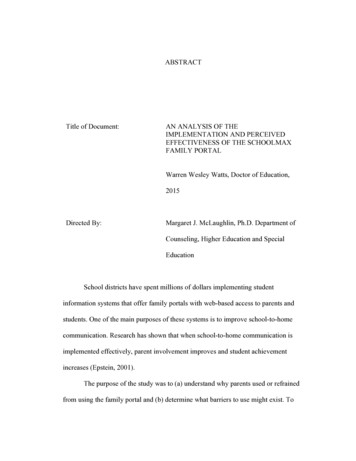
Transcription
ABSTRACTTitle of Document:AN ANALYSIS OF THEIMPLEMENTATION AND PERCEIVEDEFFECTIVENESS OF THE SCHOOLMAXFAMILY PORTALWarren Wesley Watts, Doctor of Education,2015Directed By:Margaret J. McLaughlin, Ph.D. Department ofCounseling, Higher Education and SpecialEducationSchool districts have spent millions of dollars implementing studentinformation systems that offer family portals with web-based access to parents andstudents. One of the main purposes of these systems is to improve school-to-homecommunication. Research has shown that when school-to-home communication isimplemented effectively, parent involvement improves and student achievementincreases (Epstein, 2001).The purpose of the study was to (a) understand why parents used or refrainedfrom using the family portal and (b) determine what barriers to use might exist. To
this end, this descriptive study identified the information parent users accessed in theSchoolMAX family portal, determined how frequently parents accessed the portal,and ascertained whether parents perceived an increase in communication with theirchildren about academic matters after they began accessing the portal. Finally, thestudy sought to identify whether barriers existed that prevented parents from using thefamily portal.The inquiry employed three data sources to answer the aforementionedqueries. These sources included (a) a survey sent electronically to 19,108 parents whoregistered online for the SchoolMAX family portal; (b) SchoolMAX portal usage datafrom the student information system for system usage between January 1, 2015 andJune 30, 2015; and (c) a paper survey sent to 691 parents of students that had neverused the SchoolMAX family portal in one elementary school, one middle school andone high school that were representative of other schools in the district.Survey results indicated that parents at all grade levels used the family portal.Usage data also confirmed that approximately 19% of the students had parents whomonitored their progress through the family portal. Usage data also showed thatparents were monitoring approximately 25% of students in secondary schools (6th –12th grade) and 16% of students in elementary schools. Of the wide menu of resourcesavailable through the SchoolMAX family portal, parents used three areas mostfrequently: attendance, daily grades, and report cards.Approximately 70% of parents responded that their communication hadimproved with their children about academic matters since they started using theSchoolMAX family portal, and 90% of parents responded that the SchoolMAX
family portal was an effective or somewhat effective tool. Parents also expressedinterest in the addition of additional information to the SchoolMAX family portal.Specifically, the top three additions parents wanted to see included homeworkassignments, high stakes test scores, and graduation requirements. Parents alsoreported that 92% of them spoke to their children at least 2 to 3 times per week aboutacademics.Due to the low response rate of the parent non-user survey, potential barriersto using the SchoolMAX family portal could not be addressed in this study. However,this issue may be a useful research topic in a future study.Keywords: school to home communication, student information systems, familyportal, parent portal
AN ANALYSIS OF THE IMPLEMENTATION AND PERCEIVEDEFFECTIVENESS OF THE SCHOOLMAX FAMILY PORTALByWarren Wesley WattsDissertation submitted to the Faculty of the Graduate School of theUniversity of Maryland, College Park, in partial fulfillmentof the requirements for the degree ofDoctor of Education2015Advisory Committee:Professor Margaret J McLaughlin, ChairProfessor Donna L. WisemanProfessor Helene Kalson CohenProfessor John NorrisProfessor Pamela Shetley
Copyright byWarren Wesley Watts2015
DedicationTo Patricia B. and Warren W. Watts Sr., my parents, for teaching me about life andproviding me the opportunity and direction to take this journey.To Patti, Bobby, Kathleen, Stephen, and Kenny, my sisters and brothers, for your love,friendship, and shoulders to lean on over the years.To Woody, Joey, and Aiden, my children, for being my pride and joy, my world, and myinspiration.And to my wife April, for your understanding, your support, and your love. Thank youfor allowing me to do this!ii
AcknowledgementsI wish to thank my advisor, Dr. Margaret J. McLaughlin, for her guidancethroughout my graduate program. I appreciate all of the time you spent reviewing mypaper and the constructive feedback that you provided.Thanks to all of my professors and my cohort of colleagues over the past threeyears. I enjoyed our classes, learned from each of you, and developed relationships thatwill last for years to come.Thanks to Sharon Dent for proofreading the many versions of my paper. Thanksto Ramkumar Palaniswamy and Jinghung Gao for helping me with the data.And a special thanks to my family—April, Woody, Joey, and Aiden—forproviding me the time to take the classes and complete the assignments, and forcontinuously supporting me through this process. I appreciate the sacrifices you made toprovide me this opportunity.iii
Table of ContentsDedication . iiAcknowledgements . iiiTable of Contents . ivList of Tables . viList of Figures . viiSection I: Introduction to the Problem and Literature Review . 1Family portals .2History of Information Systems in District A .3Pre-SchoolMAX SIS infrastructure .5Board action summary : Student information system contract .7Goals for the new student information system .7The SchoolMAX Implementation.9SchoolMAX go-live .10Legal and Administrative Procedures Regarding Student-Level Data .12Code of Maryland Annotated Regulations (COMAR 13A) .13Policy 5121 and Administrative Procedure 5121.1, 5121.2 and 5121.3.14SchoolMAX Family Portal and Its Evolution.16Attendance .16Schedule .16Student Course Choices .16Gradebook .21Grades .21Mobile family portal .21SchoolMAX Family Portal Usage .27Review of Research .32School to home communication using technology .32Summary .39Section II: Methodology . 42Purpose of the Study .42Research Questions .42Design and Methods .42Research Setting.43Target Population .43Instruments and Data Collection Procedures .44Survey pilot testing .45Procedures .45Data Analysis .48Human Subject Review and Confidentiality.50Summary .50Section III: Results, Conclusions and Recommendations for the District . 52Research Question 1 .52Research Question 2 .57Research Question 3 .62Research Question 4 .66iv
Research Question 5 .71Connections to the Literature .71Limitations of the Study.72Recommendations .73Summary .76Appendices. 77Appendix A: Parent User Survey . 77Appendix B: Parent User Survey (Spanish Version) . 80Appendix C: Parent Non-User Survey . 83Appendix D: Parent Non-User Survey (Spanish Version) . 85Appendix E: Email to Parent Users . 87Appendix F: Reminder Email to Parent Users . 88Appendix G: Email to Parent Users (Spanish Version) . 89Appendix H: Reminder Email to Parent Users (Spanish Version) . 90Appendix I: Recruitment Letter to Non-Users. 91Appendix J: Recruitment Letter from Researcher to Non-Users . 92Appendix K: Recruitment Letter to Non-Users (Spanish Version) . 93Appendix L: Reminder Postcard to Non-Users . 94Appendix M: Reminder Postcard to Non-Users (Spanish Version) . 95Appendix N: Glossary. 96References . 98v
List of TablesTable 1. SchoolMAX Yearly Usage Totals . 27Table 2. Percent of Families Using the SchoolMAX Family Portal. 29Table 3. Percent of Students Using the SchoolMAX Family Portal. 29Table 4. SchoolMAX Usage During First Quarter Release of Report Cards . 30Table 5. SchoolMAX Usage During Secord Quarter Release of Report Cards . 30Table 6. SchoolMAX Usage During Third Quarter Release of Report Cards. 31Table 7. SchoolMAX Usage During Forth Quarter Release of Report Cards . 31Table 8. Parent User Survey Question 3 Data . 53Table 9. Parent User Survey Question 6 Data . 55Table 10. Parent User Survey Question 1 Data . 58Table 11. Parent User Survey Question 2 Data . 60Table 12. SchoolMAX Yearly Usage Totals by Grade Level . 61Table 13. SchoolMAX Yearly Usage Totals by Elementary, Middle and High School. 63Table 14. SchoolMAX Family Portal Login Frequency (Number of Logins Over 6Months) . 65Table 15. Parent User Survey Question 4 Data . 66Table 16. Parent User Survey Question 5 Data . 68Table 17. Parent User Survey Question 7 Data . 69vi
List of FiguresFigure 1. SchoolMAX family portal: Student Profile page . 17Figure 2. SchoolMAX family portal: Attendance page . 18Figure 3. SchoolMAX family portal: Schedule page. 19Figure 4. SchoolMAX family portal: Student Course Choices page . 20Figure 5. SchoolMAX family portal: Gradebook page . 22Figure 6. SchoolMAX family portal: Unofficial Transcript page . 23Figure 7. SchoolMAX family portal: Progress Report page. 24Figure 8. Mobile family portal: Login Screen and Main Menu . 25Figure 9. Mobile family portal: Attendance and Schedule . 26Figure 10. Mobile family portal: Unofficial Transcript page . 26Figure 11. SchoolMAX usage data – Unique users report . 28Figure 12. Crosswalk between research questions and survey questions . 46Figure 13. Timeline for parent user and non-user surveys . 48Figure 14. Crosswalk for Research Question 1 . 52Figure 15. Results from Question 3 of the parent user survey. 54Figure 16. Results from Question 3 of the parent user survey by school level . 54Figure 17. Results from Question 6 of the parent user survey. 56Figure 18. Results from Question 6 of the parent user survey by school level . 56Figure 19. Crosswalk for Research Question 2 . 57Figure 20. Results from Question 1 of the parent user survey. 59Figure 21. Results from Question 1 of the parent user survey by school level . 59Figure 22. Results from Question 2 of the parent user survey. 60vii
Figure 23. Percentage of parents using family portal by student's grade level . 62Figure 24. Crosswalk for Research Question 3 . 62Figure 25. Average monthly family portal usage . 64Figure 26. Six month login usage . 65Figure 27. Crosswalk for Research Question 4 . 66Figure 28. Results from Question 4 of the parent user survey. 67Figure 29. Results from Question 5 of the parent user survey. 68Figure 30. Results from Question 7 of the parent user survey. 70Figure 31. Crosswalk for Research Question 5 . 71viii
Section I: Introduction to the Problem and Literature ReviewIn the fall of 2008, District A, a large school district on the east coast of theUnited States, implemented SchoolMAX, a 4,100,000 web-based student informationsystem designed to consolidate student information into one system that provided thedistrict’s 90,270 families access to their children’s attendance, grade, homework,schedule, transcript, and discipline information. Over the past six years, approximately25% of the families in the district have accessed the family portal, and less than 10% ofthe families use the system quarterly.SchoolMAX is District A’s student information system, and the system’s familyportal is a web-based software program that is optimized to operate on both a traditionallaptop and desktop. District staff also created the mobile family portal as a means toincrease the availability of information to students, parents, and staff. The mobile familyportal was optimized for smartphones and presents the same information as theSchoolMAX family portal. For the purposes of this study, the term SchoolMAX familyportal will refer to both the SchoolMAX family portal and the mobile family portal.District A is similar to other large school districts across the country that haveinvested millions of dollars in web-based student information systems. These systemsgive parents and students access to student information or data portals 24 hours each day(Bird, 2006). One of the main functions of modern student information systems is toprovide parents with timely information about their children’s daily performance(Weinstein, 2005). The theory of action behind the investments in these systems is thatimproving the home-school connection and fostering school-to-home communication will1
cause parents to become more involved in their children’s education, which ideally willlead to increases in student achievement (Kervin, 2005).Researchers have found that when districts implement school-to-homecommunication effectively, parent involvement improves and student achievementincreases (Epstein, 2001). The National Parent Teacher Association noted that, “Whenparents are involved in their student’s education, those students have higher grades andtest scores, better attendance, and complete homework more consistently” (Sedlacek,2011, p. 3). Further, in a series of focus groups conducted by the Center for the Study ofEducational Policy at Illinois State University, parents stressed the importance of havingmultiple methods of communication between school and home and supported the use ofthe Internet for certain types of communication (Adkins, 2004).Family portals. The term family or parent portal refers to web applications thatprovide parents with secure access to specific information about their children, like dailyattendance, grades, quarterly grades, schedules, discipline actions, and other data (Seibel,2008). The portal can be an effective way to share information and assist parents inmonitoring their child’s progress. For example, some parents are not able to visit theirchild’s school frequently, so technologies like the family portal have enabled them to stayinformed and extend school-to-home communication beyond face-to-face meetings,letters, email, and phone calls.Research has shown that most parents perceived that their use of the data in afamily portal improved communication with their children about academic matters andresulted in the students’ improved attitudes toward school and grades (Starkie, 2012).Dardenne (2010) found that both parents and teachers indicated a favorable change in2
student attitudes and behaviors when schools and families used technology as a schoolto-home communication tool. In Shayne (2008), surveyed parents again confirmed thatimproved parent-child communication occurred when parents had access to gradesonline. However, one study suggested that the use of the family portal might affectparent’s tendencies to decrease their involvement as the child moved from elementary tohigh school (Starkie, 2012). In general, however, research has clearly shown that toolslike the family portal have positive effects on school-to-home communication and parentchild communication (Ellis, 2008; Olmstead, 2011; Shayne, 2008; Starkie, 2012; Weiss,Lopez, & Stark, 2010).District A has spent well over 8 million in the last ten years implementing andmaintaining SchoolMAX. With less than 25 percent of the parents using the system, thevalue of the family portal has not been realized, and the district has missed an opportunityto improve its school-to-home connection with parents. The family portal may provideopportunities for more informed conversations between parents and students, particularlyif the portal is accessible to both parties. Therefore, it is important to understand whyparents are underutilizing the SchoolMAX system.History of Information Systems in District AIn 1999, District A’s leadership began focusing on the modernization of theadministrative information systems, including those related to human resources, benefits,general ledger, accounts payables, account receivable, and procurement. The schooldistrict began making plans to replace the aging client server-based mainframe and midrange computer systems, which required the installation of software on every workstationthat needed access to the system. The client server system was very centralized, and3
central office staff completed the majority of their data entry using paper forms filled outby school staff.At the time, most functions were paper-based, and staff entered only essentialinformation into the administrative information system. For example, when completing apurchase order, staff would type a requisition on a 9-copy thick carbon form and send itto the purchasing office, which would ensure that a contract or purchasing vehicle existedwith the vendor. Staff then sent the order to the accounting office through the inter-officemail system. The accounting office would confirm that funds were available in theschool’s account, keep a copy of the requisition, and send the original form back to thepurchasing office for approval. Once the director of purchasing approved and signed therequisition, the requisition became a purchase order and was sent to the vendor forprocessing. Another copy was to accounts payable office to have a record of the purchaseorder when invoices were received. The purchasing department would send the remainingcopies of the purchase order forms back to the originator of the purchase order to keep fortheir records. Information captured in the administrative information system was limitedto the date, amount, company, and cost center the funds were being encumbered. Therewere no records of what was purchased from the company.In 1999, the district posted a Request for Proposal (RFP) for a new AdministrativeInformation System. The district selected Oracle’s E-Business Suite to replace the agingsystems and awarded an 8 million contract to Oracle to provide the software andimplement the product. The finance modules went live in November 2002, andHR/Payroll modules went live in May 2003. Implementing any information system in alarge organization can often cause stress to the organization, even if it is well-planned4
and resourced, and can result in staff resistance, cost overrun, and delayedimplementation dates (Vaughn, 2001). These challenges occurred within District A, andby 2003, the implementation of Oracle was over budget by almost 250% and had cost thedistrict approximately 20 million.Pre-SchoolMAX SIS infrastructure. Prior to 1998, the school system relied onseveral information systems to manage student data. Elementary schools used the AS/400to capture enrollment, demographic, and daily attendance data. Prior to the 2003–2004school year, school staff completed elementary report cards and progress reports by hand.No grade information was captured or saved in the AS/400, meaning the only record ofgrades in elementary schools were the paper report cards. To improve new reportingrequirements under the No Child Left Behind Act of 2001 and enhance the quality of theelementary report cards, District A’s Technology Applications Department developed theElementary Report Card System (ERCS). The ERCS copied the paper form and made iteasy for teachers to adjust to the electronic form. The ERCS also added features likespell check and alerts to ensure each teacher submits attendance daily, and programminglogic to help schools with NCLB reporting requirements that each child in every coursehas a teacher of record listed. The report cards were more legible than teacher’shandwriting, and the system provided a database that kept grade information forelementary students. The system also began preparing teachers for the new studentinformation system, which would require teachers to take attendance and enter gradeselectronically.District A began providing teachers with laptops as a necessary administrativeand instructional tool. As the district’s technology infrastructure expanded into the5
classrooms and more instructional technology became available to them in the classroom,laptops enabled teachers to take advantage of the classroom projector; email; self-serviceapplications for payroll, leave, and benefits; the Internet; and other applications.In secondary schools, there were three information systems used to capturestudent data—the AS/400, the HP300, and SBSIS. The AS/400 was used to enrollstudents. Once students were enrolled, the AS/400 would immediately send a file to theHP3000 so the scheduler could create a class schedule for the student. The HP3000 wasprimarily responsible for capturing attendance, scheduling, progress reports, report cards,and locker information. School staff completed transcripts by hand from a student’srecord once they graduated from the district.Few members of the school-based personnel had access to either the AS/400 orthe HP3000 systems. Staff typically took attendance by sending down an envelope to theattendance secretary with the names of the students that were absent for the day. Theattendance secretary would enter then enter the data into the HP3000. Teachers typicallykept all grades and attendance information in a paper-based gradebook, and theysubmitted progress reports and quarterly grades on bubble sheets that staff imported intothe HP3000. The HP3000 operator would print out progress reports and report cards at acentral location and school staff would pick up the report cards.In an effort to improve operations, the Technology Applications Staff developedthe School-Based Student Information System (SBSIS) that allowed teachers to takeattendance and enter progress and quarterly grades on a computer in the classroom. TheSBSIS began preparing teachers for the electronic submission of attendance and gradesand streamlined the information sharing process.6
Although the AS/400 and the HP3000 performed well, there were growingconcerns about the age of the systems (both the AS/400 and the HP3000 were overtwenty years old). Hewlett Packard ended the support for the HP3000 so the schooldistrict had to find expertise elsewhere until the district could replace it. Parts for thesystems became harder to find. There was also a desire to improve operations andprovide timely information to principals, teachers, parents and students; but the districtcould not do it while supporting five different student information systems. Eventually,district leaders decided to begin planning for a new student information system.During the 2003-2004 school year, the district developed a RFP for a new studentinformation system. After months of meeting with stakeholders and data owners, thedistrict released the RFP on September 24, 2004. All bids had to be submitted to thepurchasing office by 2:00PM on October 25, 2004.Board action summary: Student information system contract. On May 5,2005, the Board of Education for District A approved a Board Action Summary thatauthorized the chief executive officer, or his designee, to execute appropriate contractdocuments to acquire and implement a student information system at a cost not to exceed 6,000,000. On June 28, 2005, District A’s purchasing director signed a contract for 5,419,350, which included an annual software maintenance agreement and help desksupport for five years.Goals for the new student information system. The school district had threemajor goals with the implementation of a new student information system: The
SchoolMAX is District A's student information system, and the system's family portal is a web-based software program that is optimized to operate on both a traditional laptop and desktop. District staff also created the mobile family portal as a means to


